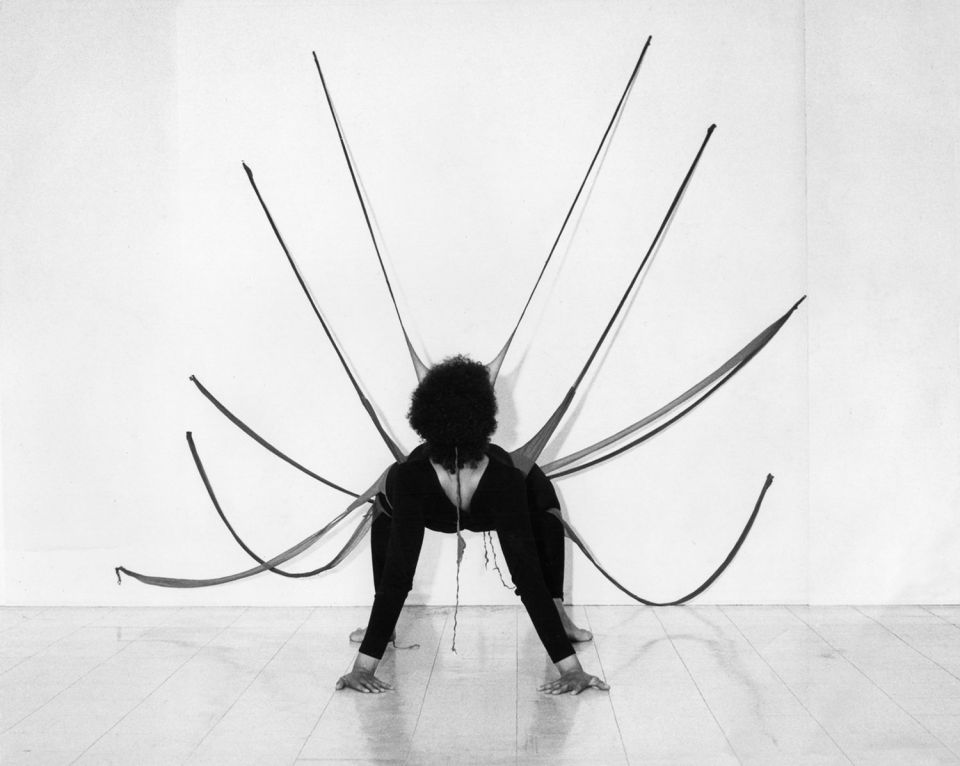It was the utmost pleasure to be invited to the opening exhibition of Senga Nengudi, one of the world’s leading avant-garde artists last week at the Leeds Henry Moore Institute.
Open until February 2019, it’s an exhibition that showcases some of the vital aspects of Nengudi’s life through the years. Race, femininity, motherhood and culture all feature prominently within the exhibition and it is, quite simply, fantastic. Nengudi’s artistry is inspirational, every piece has multiple layers of thought and is an expression of exceptional complexity from the simple and unassuming. According to Laurence Sillars, the curator of the exhibit, Nengudi “wanted to be able to take an exhibition out of her handbag.”
From a mixture of photographs documenting the influences and performative belief systems in 1978 to the rough-living urban struggle of homeless people in New York, Nengudi’s commentary is a combination of fragility and untested strength. Her work manages to create a third realm buoyed by a sense of liminality that allows a conversation to take place between the audience, the work and Senga herself. Nengudi’s personal history is a clear contributor to the exhibition itself, from the sculpture made out of the window slats from the urban area she inhabited as a child to a room so full of bits of newspaper and shocks of memory that the room itself almost becomes a palimpsest. This, perhaps, was my favourite piece of the exhibition. Layer upon layer of newspaper, collected by Nengudi’s mother and then herself, built a story of Senga’s life. Slashes of print were artfully and sometimes brutally sprayed away by gold paint to reveal messages in the print that were subtle but impactful. Combined with the word ‘bulemia’ sprayed on the wall, also in gold paint, it became the personification of that third space the rest of her work suggests. It was almost like walking into Senga’s brain, examining the emotions and pieces of her history that have resulted in her work to date.
Speaking with Nengudi herself was inspirational and discussing her influences for her work was an interesting insight into the complexities behind her artistry: “Each one is like your baby. My influences come from my personal experience as a child with the general desire to see the commonalities of different cultures. Part of it comes from my history as a woman and the idea of sensuality but it also comes from many cultures celebrate spirits and how they cope with difficult things. You have to find yourself, find your voice and go against the grain and keep experimenting.”
Speaking with Laurence Sillars, the curator of the exhibition and the head of the Henry Moore Institute’s programs, was another critical layer into the exploration and understanding of the fundamentals of both curation and Nengudi’s work. “A lot of what you see here hasn’t been seen in thirty years and has been recreated from Senga’s recipe. The entire thing is thought-provoking, it’s all a metaphor for what the body can and can’t do.” I proceeded to ask Laurence about what advice he would give to those hoping to work within a gallery in the future. “You have to be driven by passion. There are a lot of deadlines but it’s extremely rewarding getting to experience the journey through the eyes of the visitors. There are many different routes and courses, you don’t have to just go down the traditional route. It’s important that you get to know different artists and to visit as many studios and galleries as you can.”
He continued to explain that: “It’s a lot of hard work and can sometimes be difficult to fund financially, but often the joy of the exhibitions, and indeed curating itself, is the joy of the relations. You never really know what the exhibition will be like until you’ve finished, how it functions even. What many visitors expect is a pristine polish, but it’s actually a long work in progress.” This sense of immaculate conception for Nengudi’s work, or rather the absence of it, clearly resonated as I watched Nengudi at work. The sense of rawness about her work was undeniable, and it is perhaps this rawness and intensity that results in such a thought-provoking collection. Nengudi’s work is meant to be seen, touched, connected with by its audience, and that requires something that has its own kind of power.
Every installation transfigured my initial perception of traditional objects, from sand to newspaper to tights. Transformative and progressive, every piece reframed modern thought and stereotype with an acuity that never wanes. Each installation was an interactive conversation with the visitors. Despite the inherent fragility of some of the pieces, it was interactive and tactile and this only added to the impression of sensuality. As Laurence quipped, Nengudi “does a lot with not a lot.”
As his first major exhibition for the Henry Moore Institute, it is clear that Sillars, and indeed the entire team of staff working on the project, are both talented and dedicated to their craft. Their skill underpins the exhibition and helps Nengudi’s work to shine all the brighter. The exhibition is truly her life’s work and allows the conceptual pressures to bloom into a non-linear tour of her history. Senga explained that: “I really believe something is deeply personal, a universal and human experience that can be felt and understood by all.” Senga’s philosophy, her experimental, avant-garde sculptures and insightful photography reveal the world as it is, fragile but inherently and mentally enduring.
Stephanie Bennett
Image courtesy of Lévy Gordy & The Thomas Erben Gallery

